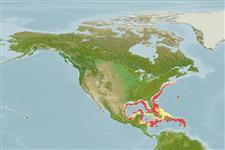Environment: milieu / climate zone / depth range / distribution range
Ecologia
marinhas demersal; intervalo de profundidade 100 - 724 m (Ref. 13203), usually 315 - 724 m (Ref. 13203). Subtropical; 41°N - 14°N
Western Atlantic: New York and northern Gulf of Mexico in USA to West Indies; southern limit uncertain
Tamanho / Peso / Idade
Maturity: Lm ? range ? - ? cm
Max length : 30.0 cm TL macho/indeterminado; (Ref. 7251)
Espinhos dorsais (total) : 6; Raios dorsais moles (total) : 16 - 17; Raios anais moles: 17 - 18. Membrane between first and second spines of first dorsal fin dark gray. Snout relatively short (1.0-1.2x eye diameter). Scales present on lateral and dorsal surfaces of snout. Upper jaw extending behind anterior margin of eye. Maxillary tentacle short and stumpy. Lateral line descending relatively abruptly beyond origin of pectoral fin, separated from origin of first dorsal fin by 4-6 rows of scales, from origin of anal fin by 5 or 6, and from insertion of anal fin by 3. No evidence of prolongation of any spine of first dorsal fin. Predorsal length for first dorsal fin almost equal to head length. Color in alcohol darker gray dorsally, lighter ventrally (Ref 13203).
Enters shelf waters.
Life cycle and mating behavior
Maturidade | Reprodução | Desova | Ovos | Fecundidade | Larvas
Das, M.K. and J.S. Nelson, 1996. Revision of the percophid genus Bembrops (Actinopterygii: Perciformes). Bull. Mar. Sci. 59(1):9-44. (Ref. 13203)
Categoria na Lista Vermelha da IUCN (Ref. 130435: Version 2024-2)
Ameaça para o homem
Harmless
Utilização humana
Ferramentas
Relatórios especiais
Descarregue XML
Fontes da internet
Estimates based on models
Preferred temperature (Ref.
123201): 6.5 - 16.4, mean 11.2 °C (based on 146 cells).
Phylogenetic diversity index (Ref.
82804): PD
50 = 0.5000 [Uniqueness, from 0.5 = low to 2.0 = high].
Bayesian length-weight: a=0.00398 (0.00192 - 0.00827), b=3.13 (2.95 - 3.31), in cm total length, based on LWR estimates for this species & (Sub)family-body (Ref.
93245).
Nível Trófico (Ref.
69278): 4.1 ±0.5 se; based on size and trophs of closest relatives
Fishing Vulnerability (Ref.
59153): Low vulnerability (20 of 100).
